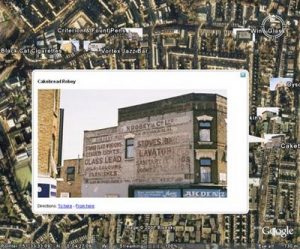Sam Roberts and Sebastian Groes
What are ghost signs? In short, they are London’s most magical and haunting presences in the form of fading advertisements once painted by hand onto buildings throughout the city, the historical and cultural significance of which is traced and investigated in this essay. These revenants from London’s commercial past have recently started to announce their presence in and impose their aesthetic on London’s consciousness by triggering a series of political debates and critical interests. There emerged a network of loosely connected people — ghost sign spotters — who capture these spectres in photographic collections which often run into the thousands of specimens.[1] Simultaneously, politicians at local, borough and London-wide level have recently debated ghost signs, often triggered by questions from the general public about the signs’ potential preservation.[2] We suggest here, in this first essay on London’s ghost signs, that they are an intricate, but neglected part of London’s cultural history, and that they express the spirit of this infinite metropolis. What is more, the critical interest currently manifesting itself is both a recapturing of their past function in the city’s economy, but also forms a reaction to the rapid changes that London is currently undergoing: the aim of preserving the signs stems from an unconscious fear of losing a genuine connection with London’s history and with past Londoners. We will provide an answer to this issue by examining the historical context of these signs, whose powerful ghostliness yields an alternative, unique map of London — see the Google Earth software below — and a knowledge that modestly illuminates an otherwise endless, unknowable city.
Before we look at London’s specific history in detail, it is important to stress that ghost signs are a form of advertising with a long history. Indeed, the etymology of the verb ‘to advertise’ derives from Latin: ‘ad’ stems from ‘towards’ and ‘vertere’ comes from ‘to turn’: advertising is about physically steering people towards a particular action, typically a purchase of goods or services. The use of walls to convey messages goes back as far back as ancient Egypt and Pompeii, with evidence of political slogans found in the remains of the ash-covered town (Nevett: 4). The earliest photographic evidence of painted wall advertising are William Fox Talbot’s Paris street scenes dating to the 1840s. In the UK, the medium experienced its heyday between the 1920s and 1950s, and went into decline beyond this era because cheap, mass-produced poster formats meant that costly hand-painted advertising was no longer economically viable. Although rare to find, modern painted advertisements do still appear, usually commissioned by sole traders or small businesses on their own premises; in developing countries such as India and Brazil, this kind of advertisement is still omnipresent. However it is worth noting that London’s ghost signs are principally located outside of the city centre. The pace of development and redevelopment of the central areas has meant that many signs have been destroyed, painted over or covered by billboards –- by definition they are usually located in highly visible places that modern advertisers would value.
In London, the popularity of outdoor advertising dates back to its medieval origins and was further catalyzed by the revolution of the printing press. However, in the seventeenth century heavy wooden and copper shop signs darkened –- literally — the city’s streets. Hanging signs were regulated and removed in 1762 after a sign outside an East End shop crashed down, killing four people (Houck: 56); such incidents were far from uncommon. The origins of ghost signs as we find them today, however, can be traced back to the early 19th century, when advertisers, as a variation on the hanging signs, used chalk on walls because this method was relatively cheap. This practice was associated with specific professions practised in London at the time, publishers, quick-doctors and blacking manufacturers in particular, and they were among the first nationwide advertisers of consumer goods by writing. According to an 1825 edition of the London Magazine:
Colburn and Warren surprise you with the variety, brilliancy and country-circulation of their advertisements. The former of the two has not yet, I believe, like the other, had his name whitewashed in letters twice as long as his Magazine upon the walls of the Metropolis and the Park-palings of the country. This is, however, a popular and striking method of advertising … more extensively patronised by gentlemen in the blacking and medical line. (Quoted in Nevett: 56)
There were also acrimonious references to ‘all the wall-chalkers of Day and Martin’ (Nevett: 56), another firm selling blacking. This method of advertising became a pervasive nuisance that provoked criticism enough for it to be curbed in the Metropolitan Police Act of 1839, which stated that ‘Every person who, without the consent of the owner of the occupier, shall affix any poster bill or other paper against or upon any wall, fence or pole, or write upon, soil, deface, or mark any such building, wall, fence, or pole with chalk or paint, or in any other way whatsoever…’ (Nevett: 127). However, to judge by old engravings and comments by contemporaries, it seems that this change in the law was impossible to enforce efficiently. Indeed, not much later The Language of the Walls (1855), by an anonymous writer, humorously mocked the way in which the omnipresence of advertisements on London’s walls revealed the mid-nineteenth century city to be one of scandalous excess and shameless hedonism:
There is nothing in heaven above, in the earth beneath, in the water, or in the air we breathe but will be found in the universal Language of the Walls. If you are in the enjoyment of health and riches, the walls will inform you where to fly for pleasure, and the names of the persons who will minster your enjoyments. If you are a lover of fun, the walls will lead you to the temple of Momus, and if you wish to be delighted with the soft strains of music, the walls will direct you to the halls of Apollo. If you have imprudently sacrificed at the shrine of pleasure beyond the limits assigned by nature, the walls will refer you to the celebrated Dr. Quackalo, whose Elixer of Life will be found an infallible cure for every “ill” that mortal “flesh is heir to”. (One Who Thinks Aloud: 2)
This allusion to Hamlet is ironic in this context: whereas commerce has not been able to shed its reputation as manipulation of human desire and projection of impossible worlds, the ghost signs themselves have changed their meaning: although they are no longer actively part of the commodification of London’s public space, they now have become objects that invite us to connect with London’s past.
Such a connection is first and foremost made through the physical act of putting up the signs themselves. The occupation of signwriter has been in decline since the second half of the 20th century due to increasing levels of sophistication in print and materials technology (Lewery, 1989). In the case of a local business or sole trader requiring a painted advertisement a local signwriter would be used to help design and execute the sign. One of the benefits of painting the advertising directly onto the wall was that the exact shape of the wall can be taken into account when designing the advertisement. These designs would often be simple and the signwriter would be able to use the bricks as grid lines in order to ensure consistently sized lettering for different elements of the design. It is common to see designs that utilise narrow vertical strips of wall or fit around the windows of the building; in other cases they would seek help in handbooks such as Arthur Payne’s Lettering (1921) and Ticket and Sign Writers’ Alphabets and Numerals (1924). This versatility is one advantage of the medium over printed poster advertising. However, for national advertisers the process was different. For these brands there would be a centrally controlled design process to ensure consistency and signwriters across the country would be issued with painters guides. These would stipulate both the layout and relative proportions of lettering and illustrations and would usually be accompanied by a colour guide. Some discretion would be granted to the sign writer in order to accommodate the specific space available on certain walls but there would be guidance on what types of wall to avoid, such as those likely to be obscured by trees in the summer. In order to transfer the small design from the painters guide onto the much larger wall space the layout would be divided into small squares using a grid. The elements of the design within each of these small squares would then be transferred by hand onto large sheets of paper or cloth. The lines would then be perforated using a toothed ‘pounce wheel’. Mounting the perforated sheet onto the relevant part of the wall would then allow the design outline to be transferred by using a ‘pounce bag’, a coarsely woven bag filled with powdered chalk, leaving the design in place once the sheet was removed. The signwriter would then apply the paints; starting with the lighter colours so that the darker colours applied later would cover any inaccuracies. The paints used contained white lead which, although later discovered to be harmful, allowed for a flatter finish to the final sign. This substance is also credited with giving the signs much of their durability.
The emergence of what we now call ghost signs is tied to a specific era that saw a exponential growth in the development of both London’s and the nation’s public transport, and they are catalyzed in particular by the railways. This becomes clear, for example, from the many advertisements one finds around both still operational and now defunct railway stations in and around London. An example is Harringay train station, in the Borough of Haringey, North London, adjacent to which two signs are positioned for viewing from train carriage windows and the platform.
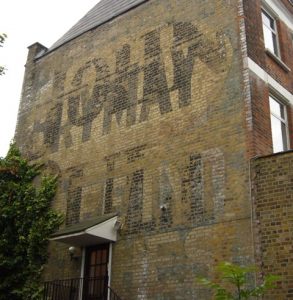
The position of the signs is worth considering: signs often appear on the higher floors of buildings, suggesting that they were appealing to as wide a public as possible, from pedestrians to citizens using elevated means of transport, such as double decker buses, trams or trains. As the low vantage point obscures the driver’s vertical vision, they are not easily seen from motor cars, a more modern mode of transportation. The positioning thus reflects the principle modes of transport at the time they were used; many of today’s billboards are at much lower levels. Outdoor advertising is further intertwined with a variety of transportation because it has three unique characteristics. First, it does not circulate a message to buyers but makes the market circulate around the message; second, the advertising is delivered to a moving rather than static audience that is actively trying to reach some destination; Third, as there is no time for detailed communication, presentations need to be made quickly and simply; the consumer is exposed to an advertisement about six seconds. (Tocker, 1969: 14-15) The painted version of this outdoor advertising could be said to form a ‘missing link’ in the evolution of mass communication, which has seen information become increasingly ephemeral and communication increasingly shorter: while the Egyptians carved their messages into stone lasting thousands of year and paper is (in favourable circumstances) able to keep for hundreds of years, television creates advertising lasting perhaps a season (at most) while communication via the Internet is even more temporary and fast-changing. Painted advertising, depending on the paint used and the weather conditions, keeps for about seventy to one hundred years but, despite its unique characteristics, in the history of advertising this specific, painted kind of mural advertising is often overlooked: advertising histories leap from early printed advertisements and placard-carriers to the modern poster, and are specifically interested in the emergence of neon signs and new media. However, this negligence also explains why painted advertising has now re-emerged in the shape of ghost signs: precisely because it has been left dormant, the medium has now been enabled to question the present, as will be demonstrated in more detail below.
The surge in outdoor advertising in relationship to the development of the railways also suggests ghost signs are expressions of a specific stage in the development of London as a centre of capitalism. The signs offer insights into the time in which they prevailed. This was an era when the emergence and establishment of big brand names was taking place. Many of the signs for brands such as Bovril, Brymay and BP feature little more than the name and, in some cases, a basic illustration of the product. There is rarely any product benefit highlighted, reflecting the use of the medium as a mechanism by which to establish the name in the consciousness of the British public. In many cases the advertising would promote the goods and services available within the building itself, but there are also numerous surviving examples of larger scale campaigns from companies such as Gillette and Redferns Rubber. They can be found all over the UK, with the industrial centres featuring the most examples. Therefore, the signs are representative of the shift from locally based commerce to the dominance of large retailers and manufacturers. They originate from a time when everyday shopping was done at a variety of local outlets (butcher, baker, chemist et cetera) and where the proprietors of these outlets would be local people serving local people.[3]
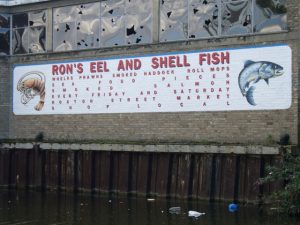
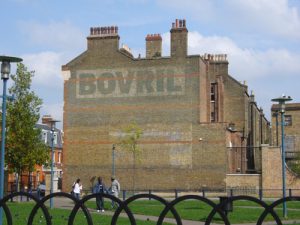
This may be demonstrated by juxtaposing two sets of classic London ghost signs, with, on the one hand, two brands that have disappeared (Black Cat and Peterkin), and, on the other hand, two brands that continue to exist (Gillette and Hovis). Black Cat Cigarettes was first introduced to the English market in 1904 by Carreras Ltd , the company of a London-based Spanish nobleman, which was by then well-established in the tobacco market. Carreras built the art deco Greater London House in Mornington Crescent as a factory in 1926, and Black Cat was one of the first machine manufactured cigarette brands in the UK. The cat itself owes its origins to a real black cat that used to reside in Don Jose Carreras Ferrer’s Wardour Street shop.
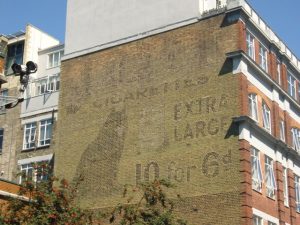
The use of colour and two illustrations would have made this a relatively expensive sign to commission, with a talented signwriter used to ensure the high quality of craftsmanship. There is no evidence of this site being used to feature advertising before or after this sign was painted, hence the sign’s clarity. The higher level of fading at the top of the sign has been caused by this area’s intensified exposure to the elements, with the lower parts of the sign being offered greater protection by the buildings nearby. The size, colour and design are so far unique in London, with no evidence of this being part of a larger campaign. Following huge popularity in pre-war Britain the brand was eventually withdrawn permanently from the UK market in the face of increasing competition from filtered brands. Carreras later merged with Rothman in 1958.
The Peterkin flour Mill in Battersea was run by Joseph Arthur Rank, whose later exploits in the British film industry earned him more renown then his milling activities, which eventually failed, forcing him to return to work for his father, who was also a miller. Rank’s father continued in the milling trade and the success of his company led to the 1962 merger with two other mills, Hovis and McDougall. Rank Hovis McDougall then became RHM and was bought by Premier Foods in 2007. Besides this sign there are no known references to the Peterkin brand, not even in the extensive collections at the History of Advertising Trust and the Notting Hill Museum of Brands, Packaging and Advertising. This classic sign for Peterkin’s Custard, Self-Raising Flour and Corn Flour, dating from the early 1930s, can be seen on St John’s Hill near Clapham Junction Station. It was preserved because it was later covered by a sign board which was removed to reveal the painted sign beneath.
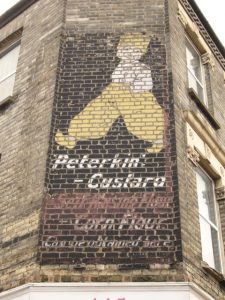
In contrast, Gillette and Hovis are brands that have continued to exist. Gillette is a well-known brand that was once one of London’s most prolific users of the painted wall advertising medium: there are surviving examples of the brand’s presence in Stoke Newington, Dalston, Spitalfields, Bloomsbury, Clapham, Southwark and Kilburn. The Gillette signs primarily focus on promoting their razors and blades, the core product on which the company’s success was built. They are very consistent in terms of the typeface and colour used, a distinctive sharp blue that can be seen on every specimen. This consistency would have come about through the central issuing of a very detailed and strict painters guide.
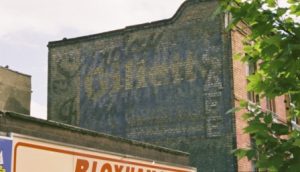
Gillette clearly understood the value of consistency and repetition when building a brand. It was sold in January 2005 to P&G for £31 billion, of which only 13% £4 billion consisted of tangible assets.[4] The remaining value (£27) billion lay in the brand and other intangible assets demonstrating that the name and its associations carry immense value, which have been generated by the company’s one-time use of hand painted wall advertising.
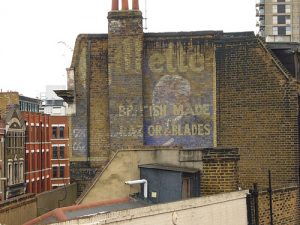
Hovis ghost signs can also be found all over London, and their prolific nature comes from a clever use of the medium. This brand was an enthusiastic user of the ‘privilege model’ (Stage, 1989), whereby the company would pay for a baker to have a sign in return for wall space to promote their product. As a result there are many Hovis signs but, in all cases, sitting alongside them are the names of bakers (such as J.T. Turner and A.H. Fryer) that once used their flour. Developing this relationship with the bakers was not only a strong distribution strategy but it also allowed the brand to lodge itself into the public consciousness as a localized business rather than an anonymous, corporate brand.
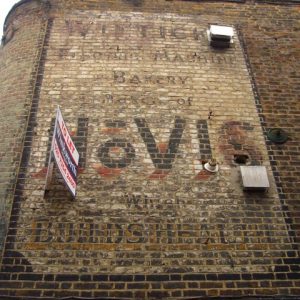

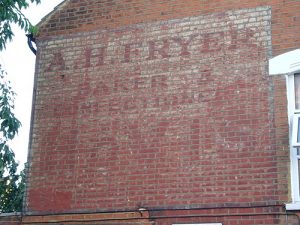
The consistency of the Hovis signs shows that the company kept strict control over their design. A Hovis painters’ guide for the backs of vans at the History of Advertising Trust provides evidence of this, stating ‘Block letters not less than 9 inches. Others in proportion’. The company eventually ceased using painted signs and began to issue bakers with metal plaques and hanging signs, many of which remain across the country in their distinctive green and gold colouring. Hovis used to conduct a rolling audit of the condition of these metal signs in order to administer their replacement. The last of these took place after the decline of Empire in the 1980s, but the brand continues to exist as part of the British consciousness.
Despite still being part of a local and national framework, this kind of advertising was able to develop into a specific economic context partly because of Britain’s? development as Empire. There are many examples of products introduced by trading with the empire such as tobacco and tea and it is also worth noting the term ‘British’ used in the context of representing quality and authenticity. Roy Porter notes in his social history of London:
As the new [twentieth] century dawned, London’s position at the hub of the world’s largest empire gave work to half a million in the docks and in import-related occupations … London’s wealthy created demand for labour galore in the transport, food and retail industries and in domestic service. Building catering, clothing, shops and hotels expanded as Victorian prosperity became Edwardian conspicuous consumption. London was the world’s biggest consumer. (Porter 398-99)
These signs are dying remnants reminding the spectator of the days when London functioned as the centre of the British Empire, and feeding off the spoils produced in the colonies. Although the advertisements are clearly part of a nation-building strategy, as is suggested by the recurrence phrase ‘British Made’, the actual fading of these signs forms an ironic visualisation of an Empire in decline and post-imperial decline itself; they could be construed as part of a mythology of loss that is a particularly strong current in this nation’s consciousness and literature. However, these signs, paradoxically, can also be tied into the resurgence of London as one of the three hegemonic economic nodes in the contemporary global economy. Indeed, Naomi Klein’s bible on anti-globalization, No Logo (2000) opens with a vista onto ‘faded signs painted on brick walls advertising long-discontinued brands’ (Klein xi), the history of which she traces back to the 19th century, showing that the origins of globalisation as we experience it today is a continuation of earlier forms of imperialism. In a way similar, London’s Gillette and Barclays ghost signs stress both the continuity and relationship between London’s and Britain’s economic development during the industrial revolution and late capitalism, whilst, paradoxically, the signs’ moribund status suggests a discontinuity with the past. It is this tension and ambivalence that gives the signs their value, as they connect us with the past in a meaningful and often unexpected manner.
The question that arises is whether ghost signs should be preserved, as some members of the public have demanded, or whether their aesthetic and charm would be compromised by any form of regulation. Traditionally, London’s cultural memory has been preserved in a variety of ways and forms: it has be museumized, turned into documentaries and books, creatively transfigured into novels, poems, and songs, and it has been institutionalized by the academe. Often it is simply not remembered, and culture mutates or disappears, in some cases for good whilst sometimes making a re-appearance in similar forms or different shapes. The act of preserving is problematic in itself: in his classic, anti-Thatcherite exploration of London’s cultural history Theatres of Memory (1994), Raphael Samuel is opposed to the artificial conservation of historical sites by the heritage culture that has sprung up since the disconnections taking place during the sixties, not because he finds that such sites in themselves are not worth preserving, but because their preservation implies the contrived, and motivated rewriting of a nation’s cultural and historic narrative for political and. conservationist or ‘ressurectionist’ strategies are dangerous because they are based on delusional ideas about a nation’s past, reinforcing myths of loss and stereotypes that lead to cultural regression.
However, we would suggest that the two subversive and democratic ways in which culture survives –- allowing us to approach cultural history –- are, on the one hand, in subversive, countercultural cultural production and in oral communication, which creates mythologies that have been classified by Michael Moorcock as ‘authentic myth’ (Moorcock, 2001: 239), which is not part of official narrative but popular knowledge that derives its power from effacing the boundary between fact and fiction, and which is passed on orally. On the other hand, there is a form of knowledge that is available to all: the narrative that is present in the form of the metropolis as a material structure. If we read London as a collection of signs, an act that will be explored in a follow-up essay in this journal, we have the expression of the city in its purest form. This we can do, however, only with a vision that is partial, subjective, peripheral: ghost signs offer an alternative experience of the city that is not recoverable by mainstream regulation: they offer a mode of vision that subverts an everyday order dominated by conventional signs regulating public life: in other words, it is not the signs themselves but the act of our discovering them that illustrates the city’s economic evolution. This is precisely why regulation of their status works against the power of their signification: ghost signs are fascinating because of their ambivalence: on the one hand, they offer a reminder of a London that has disappeared; yet, on the other hand, their presence forms a testimony to the idea that nothing ever truly disappears: buildings, people and phenomena are ‘overwritten’, but hardly ever replaced or effaced from London’s memory. In Iain Sinclair’s words, the ghost sign ‘holds memory of what it was: it is possible to walk back into the previous, as an event, still true to this moment […] The past is a fiction that absorbs us. It needs no passport, turn the corner and it is with you.’ (Sinclair: 63) Therefore, the blanket preservation of ghost signs is unnecessary: the current debate, and the conservation of a number of specimens, enact forms redemption and atonement, in the form of a modest memorialization that is not restrictive in its regulations: any legal intervention will compromise their part in London’s unnatural evolution. This leaves the ghost signs free to enact their powerful, but ambivalent meanings, while not inviting us to fall into the trap of naive nostalgia. The following quotation, from The Language of the Walls, suggests why we should not mourn their loss:
Amid all the changes which this changing age has produced, that of the walls superceding the town’s bell-man is perhaps the most melancholy. The loss of these functionaries has been a sad blow to corporation patronage in many of our good old towns. In looking back into the dreamy past with all its misty enjoyments, sonorous sound of John Hotton’s bell, and his stentorian voice, (which could be heard from a distance of about three miles, weather permitting) yet sounds in all its vibrating cadence upon our green memory. (By One Who Thinks Aloud: 383-84)
© All photography by Sam Roberts (www.ghostsigns.co.uk).
Some of the images in this essay and others can be viewed, in-situ, via Google Earth. In order to view these you will need to ensure you have the appropriate free software available at http://earth.google.com/.
Once you have downloaded the software the link below will allow a partial insight into the mapping of London’s ghost signs: http://bbs.keyhole.com/ubb/download.php?Number=740248
Endnotes
[1] Collectors include Louis Sheldon Williams with an extensive collection of signs from London, the UK, France and beyond, Martin Thompson who has turned many of his into artworks, former sign writer Chris Bramley, Sam Roberts who documents his exploits at http://www.ghostsigns.co.uk and countless enthusiasts on photo sharing website Flickr.
[2] A judge ruled in favour of a Battersea sign not being covered by an advertising billboard in May 2007 and official responses have been received from local councils including Hackney and Lambeth as well as Ken Livingston and the GLA. Interest has also come from the media with a number of local newspapers and ITN picking up on the political aspects.
[3] The recent creation of a number of painted signs for local businesses by artist Bob and Roberta Smith in a campaign called ‘Shop Local’ in Hoxton was designed to highlight the negative aspects of this shift.
[4] Source: IPA (www.ipa.co.uk)
Works Cited
Anonymous (One Who Thinks Aloud), The Language of the Walls: and, A Voice from the Shop Windows, or, the Mirror of Commercial Roguery. Manchester: Abel Heywood, 1855.
Unsigned, Tickets and Sign Writers’ Alphabets and Numerals. London: Austin Rogers, 1924.
Elliott, Blanche B., A History of English Advertising. London: Business Publications, 1962
Haas, C, Ghost Signs of Arkansas. Fayetteville, Arkansas: The University of Arkansas Press, 1997.
History of Advertising Trust, www.hatads.org.uk
Lewery, A. J., Signwritten Art. Newton Abbot: David & Charles, 1989
Nevett, T. R., Advertising in Britain: A History. London: Heinemann, 1982.
Passikoff, Ben, The Writing on the Wall, Milton Keynes: AuthorHouse, 2006.
Payne, Arthur E., Lettering: A Handbook for Artists, Architects, Designers, Sign Writers & Craftsmen. London: Bratsford, 1921.
Porter, Roy, London: A Social History. London: Penguin, 2000. Originally published by Hamish Hamilton in 1994.
Richards, Thomas, The Commodity Culture of Victorian England: Advertising and Spectacle, 1915-1914. London and New York: Verso, 1990.
Roberts, Sam, http://www.ghostsigns.co.uk
Stage, William , Ghost Signs: Brick Wall Signs in America. Cincinnati: ST Publications, 1989
Tocker, Phillip, ‘Standardized outdoor advertising: History, Economics and Self-regulation’, in Houck, John W., Outdoor Advertising: History and Regulation. Notre Dame, Indiana and London: University of Notre Dame Press, 1969.
To Cite This Article:
Sam Roberts and Sebastian Groes, ‘Ghost Signs: London’s fading Spectacle of History’. Literary London: Interdisciplinary Studies in the Representation of London, Volume 5 Number 2 (September 2007). Online at http://www.literarylondon.org/london-journal/september2007/robertsgroes.html. Accessed on [date of access]

